“We often overlook this humble technique, yet it’s such an important tool for expressive rhythm and lead playing”: How to palm mute on guitar – and take it from beginner to pro
First used by ’50s legends Chet Atkins and Les Paul, it is rock, metal and punk that have made palm muting so popular today
Back in the ’50s, Chet Atkins used palm muting for his walking basslines on the lower strings while upper register chords were left unmuted. This combination of muted/not muted sounded like two guitars playing together. In the same decade, Les Paul used muting for his fast picking lines across all six strings, making his lead phrasing punchy and dynamic.
A few decades later, palm muting evolved further, not least because of the broader guitar tones being used across more genres. From the thick chugging riffs by Metallica and Megadeth to the tight clean funk of Nile Rodgers, we often overlook this humble technique, yet it’s such an important tool for expressive rhythm and lead playing.
Palm muting is achieved by lightly placing the fleshy side of the picking hand at the bridge, just covering the strings. Be careful how much pressure is used as heavy picking hand placement on a guitar with a floating vibrato bridge (eg Stratocasters with vintage bridges and Floyd Rose-equipped Superstrats) can stretch the strings out of tune.
By exploring how much palm is used to rest on the strings, it is possible to achieve various degrees of muting, moving a millimeter or two forwards or backwards as required. Start on the lower bass strings as that is easier for picking hand placement then move onto to the higher treble strings.
Once your muting is mastered, you can add accents to riffs by adding in non muted notes. This makes simple rhythm parts more interesting. Great examples of this muted/not muted approach can be heard in the intro riff to Summer of ’69 by Bryan Adams as well as Basket Case by Green Day.
Using more amp or pedal distortion as well as applying heavier palm muting will help you achieve the metal chug that is associated with Metallica, Pantera and Periphery.
Palm muting is also an expressive phrasing tool for lead guitar, allowing for contrasts between tight muted figures and accented phrases. For example, Al Di Meola and Steve Morse use palm muting to great effect, especially for fast-picked lines and syncopated arpeggios.
All the latest guitar news, interviews, lessons, reviews, deals and more, direct to your inbox!
Now onto the playing examples to get your palm muting like the pros: use the video above in conjunction with the tab – all audio is below.
Tab examples
Example 1. Open-string palm muting
This is a great and simple introduction to palm muting. Play the low open E string with a consistent eighth note rhythm.
Gently place the side of your picking hand on the bridge, lightly touching the strings to produce a muted and bassy sound. Practice this with all down-picks, keeping your hand relaxed and the muting consistent.
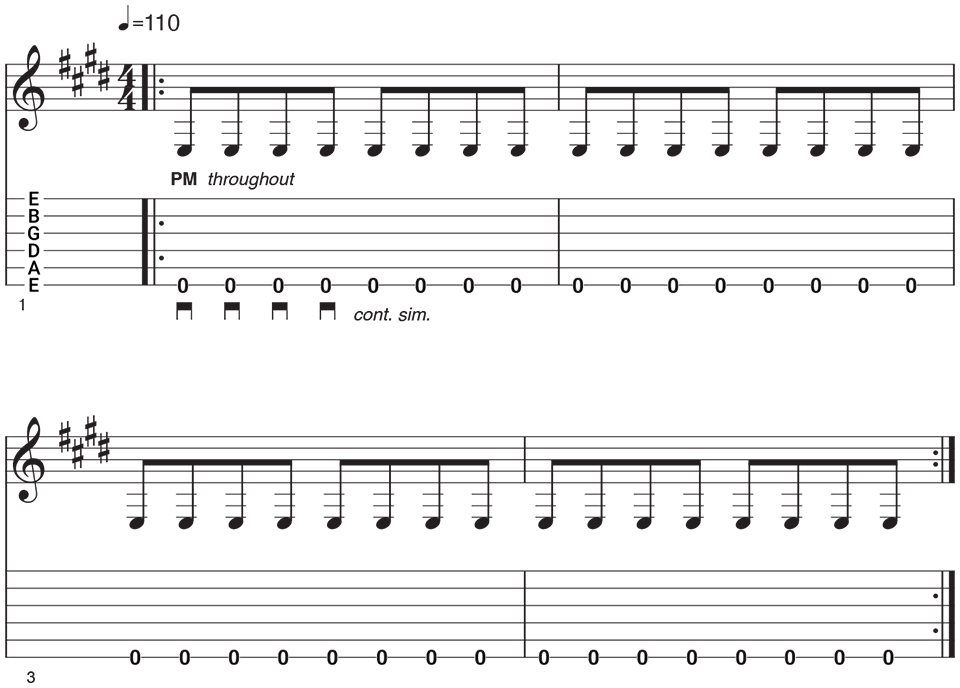
Example 2. Power chord palm muting
We now introduce palm muting to power chords played on two strings. Once again, apply the mute with the side of the picking hand, finding the point where the chord is muted but still clear.
Use a constant eighth note rhythm performed with down picks, taking care to only strike the two fretted strings. Check out the intro to Turn It On Again by Genesis or All the Small Things by blink-182 to hear great palm-muted chord riffs.
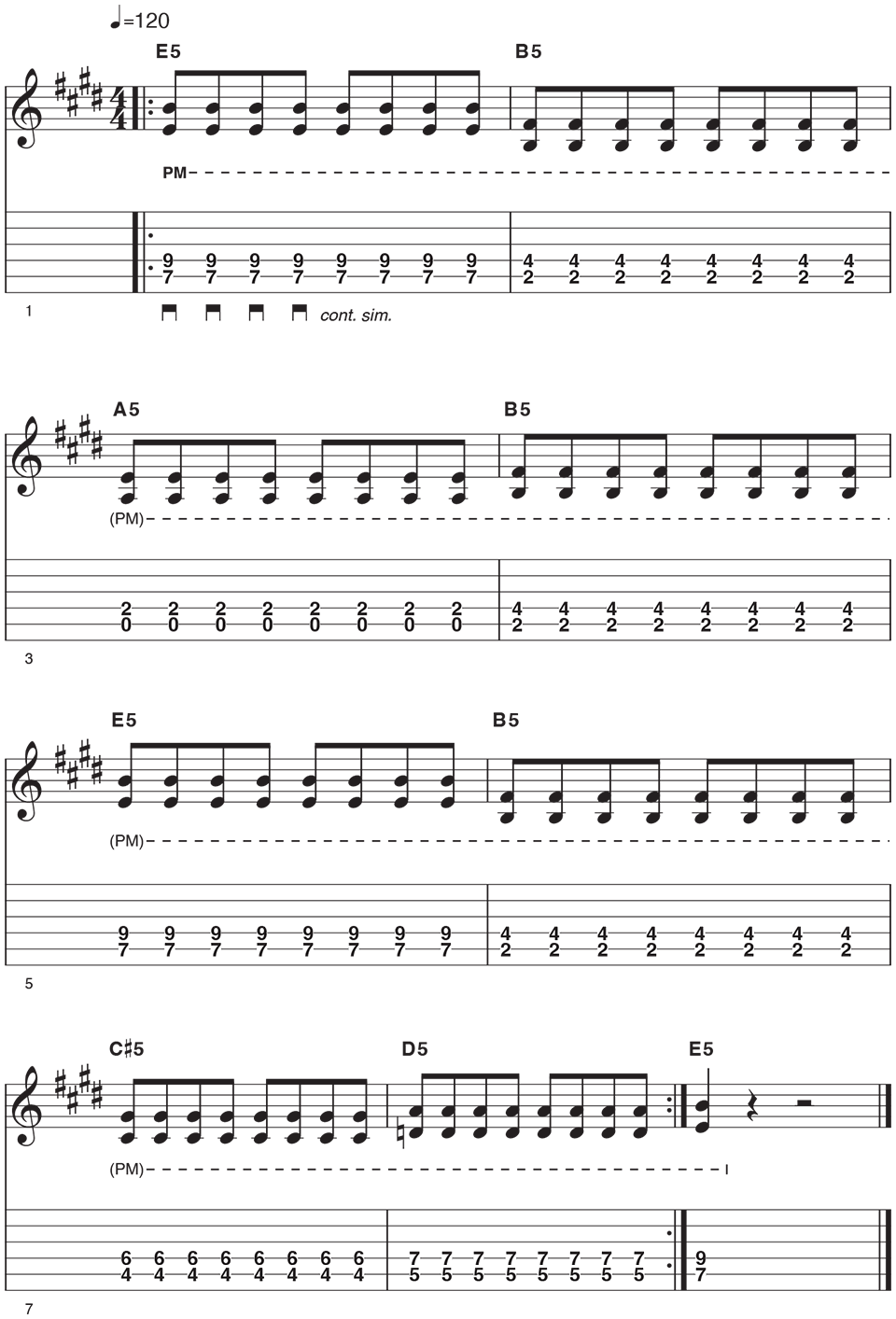
Example 3. Muted and non-muted power chords
This involves three string power chords using palm muting and non muting. Here, the top two notes of the power chord are accented (not muted), contrasting with the muted low E notes. For the second half, there are a palm muted double stops on the higher strings.
Palm muting higher strings can be challenging as there will be a slight position change required for your picking hand. Check out ’80s classic such as The Heat Is On by Glenn Frey and The Power of Love by Huey Lewis and the News for melodic palm muting.
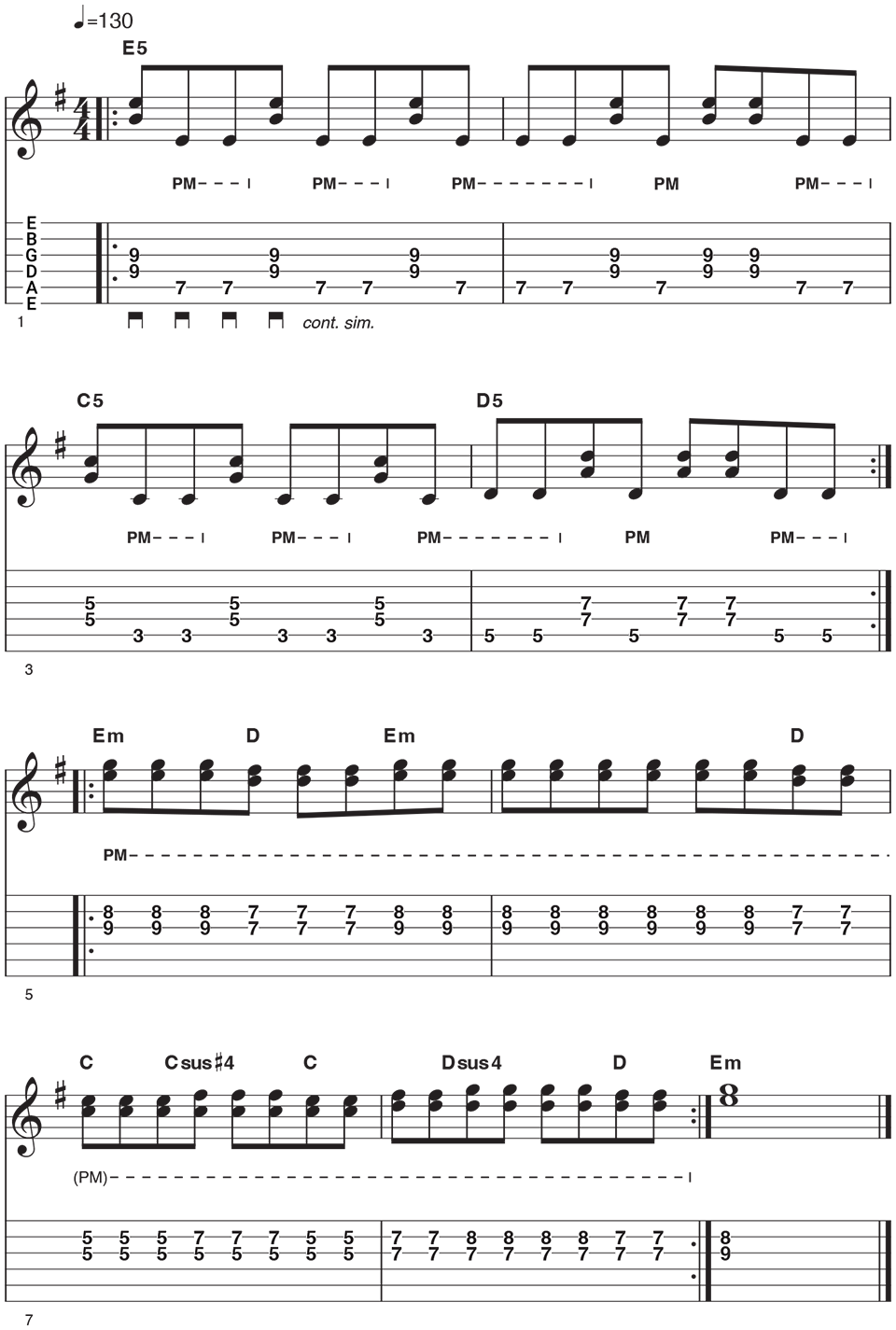
Example 4. Palm muting, metal style
This demonstrates a heavier muted approach to achieve the popular metal chug effect. Use a rich distorted guitar tone with your bridge pickup and enhanced palm muting by moving your picking hand very slightly forward towards the bridge pickup – experiment by 1mm at a time (a tiny movement can make all the difference).
The busy syncopated rhythm involves muted/non muted power chords, some fretboard positions shifts and precise rests (silences).
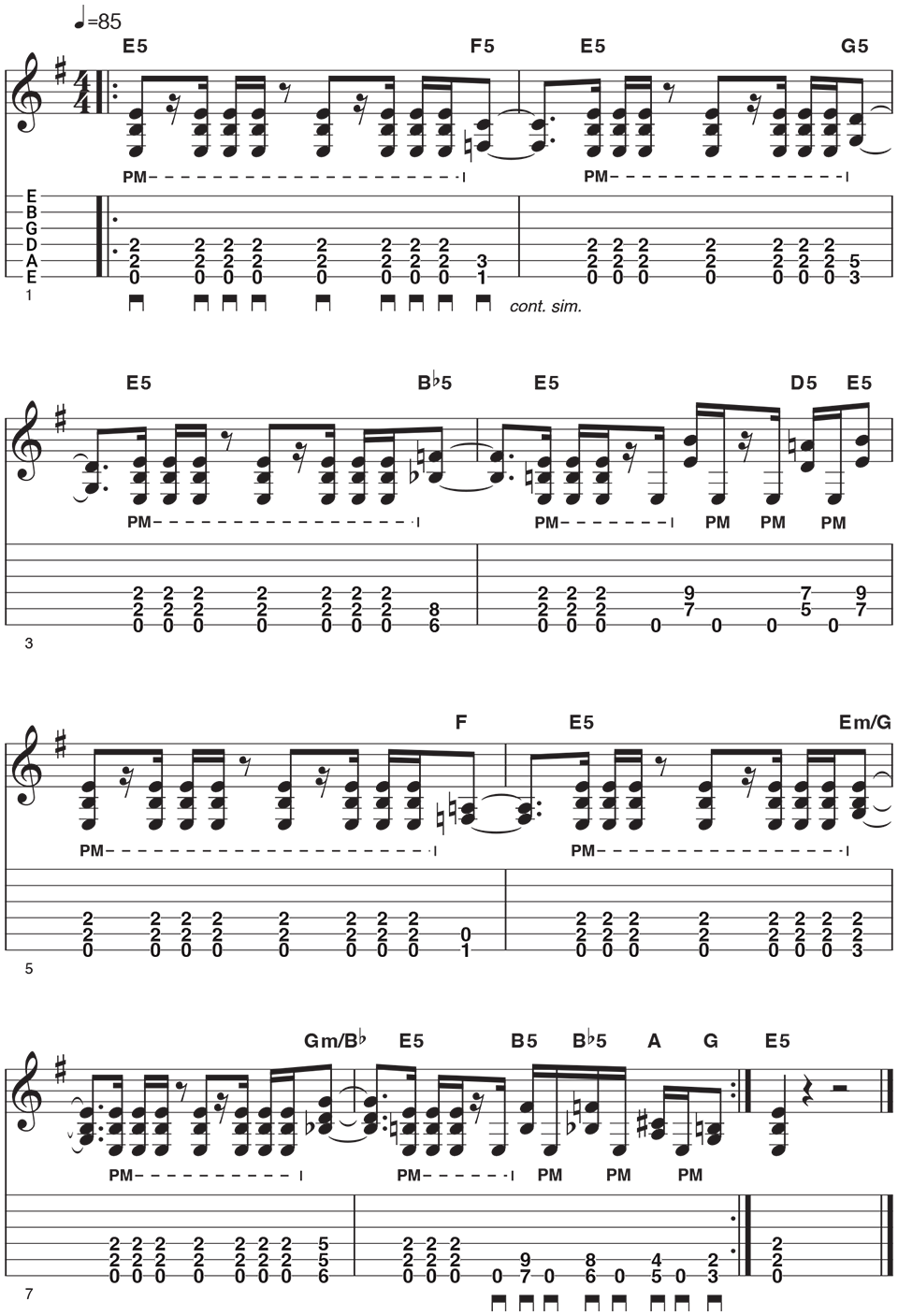
Example 5. Palm-muted lead line
This is a short lick that shows how palm muting can be used in a lead context; think Gary Moore (Out In the Fields) or Jason Becker (Altitudes).
Based around E natural minor (E Aeolian mode), the ascending run switches between non muted legato flurries and palm muted picking.
The example concludes with a palm muted pedal tone lick, with the lower E note muted whilst the upper moving line of the lick is un-muted.
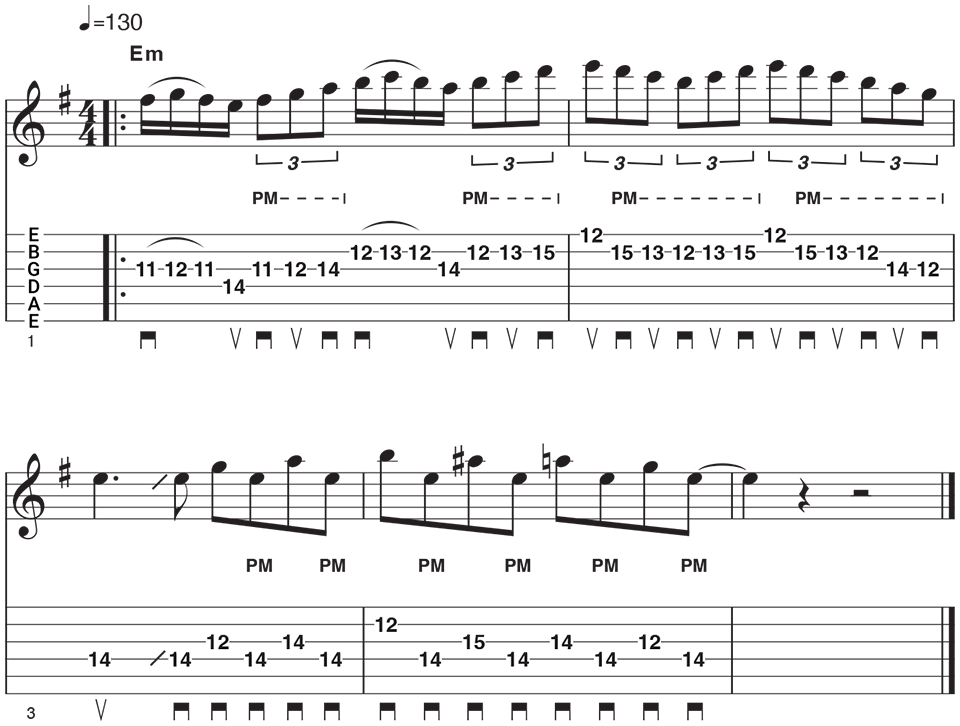
Example 6. Palm-muted riff and lead piece
For this final example, the techniques and concepts featured earlier are put together to create a short piece. The opening riff features a syncopated rhythm, with silences on beats 1 and 3.
In contrast, the second riff features a tight pedal tone figure based on a single note melody and power chords, pedalling off the palm muted fifth string.
The solo section kicks off with a melodic palm-muted pedal tone figure that outlines the accompanying chords of C5 and D5. Take care with the palm-muted pedal tone on the third string.
The solo finishes with a lick that combines legato with palm muted picking, climaxing with a percussive E minor pentatonic sequence.
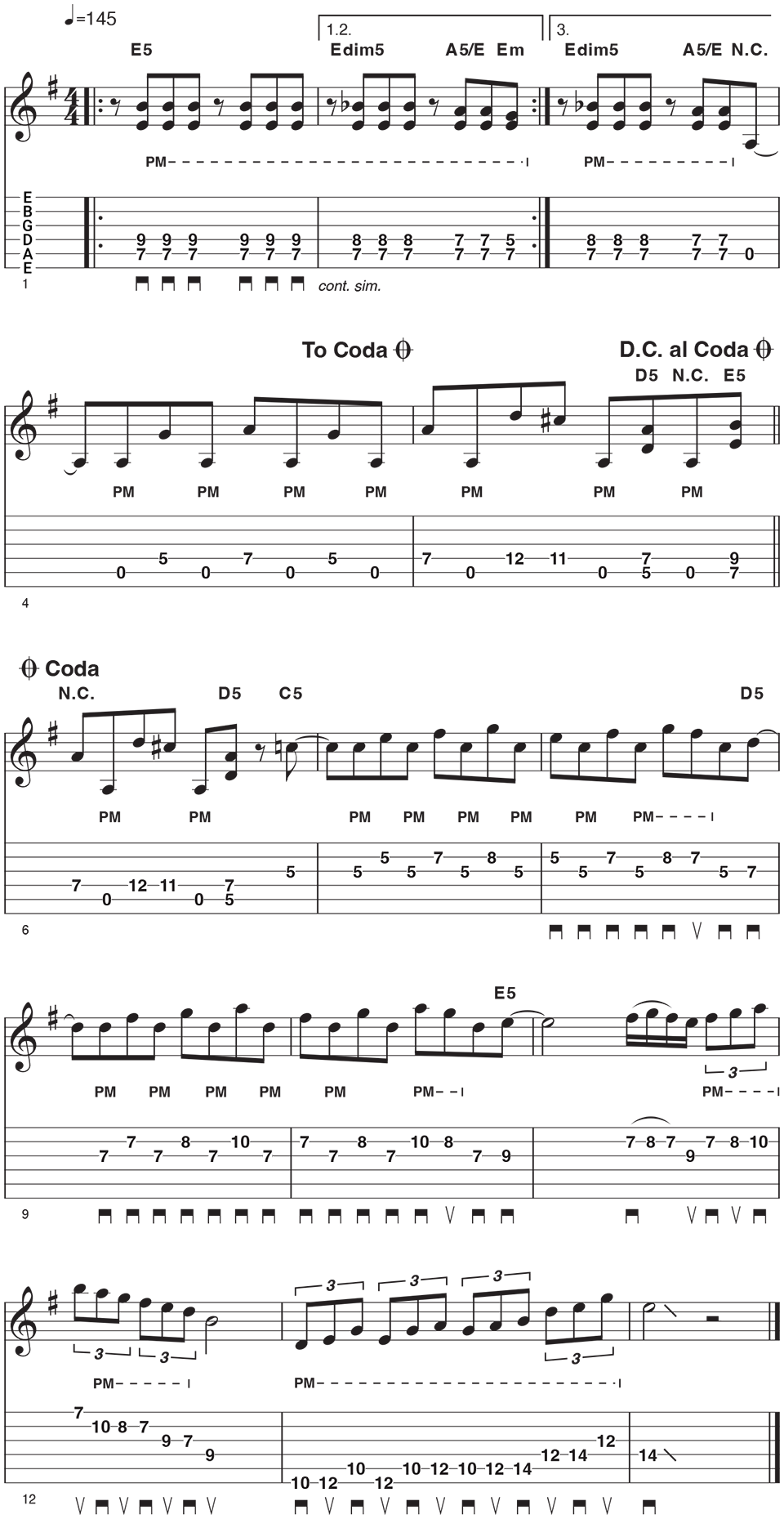
Palm muting songs
Steve Morse - Tumeni Notes
This jaw dropping instrumental features some of Steve’s most inspired guitar playing and highlights how he includes palm muting in a lead guitar context. We hear Steve applying palm muting to the fast clean tone alternate picked arpeggios during the bridge section of the song.
Steve also adds dynamic excitement to the sextuplet picking figure at the end of the solo, palm muting the chromatic line whilst accenting the top melody of the figure.
Bryan Adams - Summer of ’69
Where would this song be without palm muting? The intro riff is a great example of how this technique can elevate a basic single chord/eighth note pattern, combining muting with non-muted accents to create one of the most recognisable riffs in rock history.
Van Halen - Aint Talkin’ ’Bout Love

While Eddie Van Halen used palm muting a lot, this classic from Van Halen’s debut is a great example of how palm muting can create a tight and dynamic riff.
The intro's distortion rich picking features well placed muting to add clarity to the chord arpeggios. This technique works in contrast to the final single note figure of the riff where muting stops. An iconic riff indeed!
Jamie Humphries is an English guitarist based in Sweden. He has toured and performed with artists such as Brian May, Queen, Jeff Beck and Henry Rollins, as well as performing across Europe for We Will Rock You and in America with the Australian Pink Floyd Show. He was a longtime contributor to Guitar Techniques magazine and contributes lessons for Gibson. He runs his own studio in Stockholm where he produces Youtube content for Six String Alliance and Produce Like A Pro. He is a Music Man and Mesa/Boogie endorsee.
You must confirm your public display name before commenting
Please logout and then login again, you will then be prompted to enter your display name.



